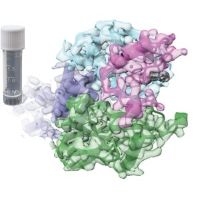Specification
| Organism | Homo sapiens (Human) |
| Expression Host | E.coli |
| Tag Info | N-terminal 6xHis-SUMO-tagged |
| Purity | Greater than 85% by SDS-PAGE |
| Uniprot ID | Q96F44 |
| Gene Names | TRIM11 |
| Alternative Names | Protein BIA1RING finger protein 92Tripartite motif-containing protein 11 |
| Expression Region | Partial(267-468aa ) |
| Molecular Weight | 38.5 kDa |
| Protein Sequence | MELRTVCRVPGLVETLRRFRGDVTLDPDTANPELILSEDRRSVQRGDLRQALPDSPERFDPGPCVLGQERFTSGRHYWEVEVGDRTSWALGVCRENVNRKEKGELSAGNGFWILVFLGSYYNSSERALAPLRDPPRRVGIFLDYEAGHLSFYSATDGSLLFIFPEIPFSGTLRPLFSPLSSSPTPMTICRPKGGSGDTLAPQ |
| Form | Liquid or Lyophilization |
| Buffer | The default storage buffer is Tris/PBS-based buffer, 5%-50% glycerol if the delivery form is liquid. The lyophilization buffer is Tris/PBS-based buffer, 6% Trehalose, pH 8.0 if the delivery form is lyophilized powder. Please contact us if you have any special requirment. |
| Reconstitution | Please reconstitute protein in deionized sterile water and we recommend that briefly centrifuge thevial prior to opening the vial .We recommend aliquot for long-term storage at -20℃/-80℃. |
Background
| Relevance | E3 ubiquitin-protein ligase that promotes the degradation of insoluble ubiquitinated proteins, including insoluble PAX6, poly-Gln repeat expanded HTT and poly-Ala repeat expanded ARX. Mediates PAX6 ubiquitination leading to proteasomal degradation, thereby modulating cortical neurogenesis. May also inhibit PAX6 transcriptional activity, possibly in part by preventing the binding of PAX6 to its consensus sequences. May contribute to the regulation of the intracellular level of HN (humanin) or HN-containing proteins through the proteasomal degradation pathway. Mediates MED15 ubiquitination leading to proteasomal degradation. May contribute to the innate restriction of retroviruses. Upon overexpression, reduces HIV-1 and murine leukia virus infectivity, by suppressing viral gene expression. Antiviral activity depends on a functional E3 ubiquitin-protein ligase domain. May regulate TRIM5 turnover via the proteasome pathway, thus counteracting the TRIM5-mediated cross-species restriction of retroviral infection at early stages of the retroviral life cycle. |
| Involvement in Disease | |
| Subcellular Location | Cytoplasm, Nucleus |
| Protein Families | TRIM/RBCC family |
| Tissue Specificity | TRIM11 |
QC Data
| Note | Please contact us for QC Data |
| Product Image (Reference Only) |  |

